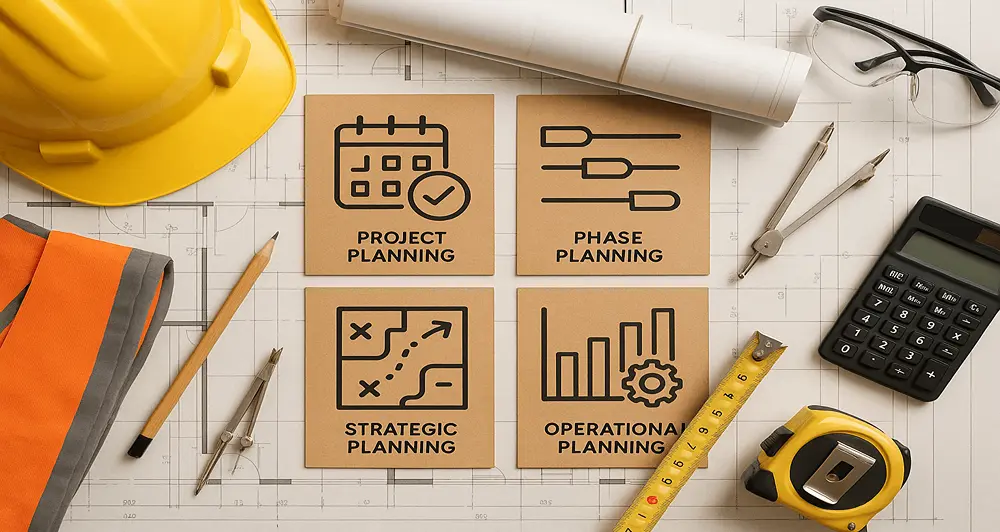Effective construction planning shapes every project’s outcome, often deciding if it finishes on time and within budget. Exploring the types of construction planning reveals categories like strategic, operational, and risk-focused approaches that streamline processes. According to McKinsey’s 2023 report, proper planning cuts project delays by 35%, boosting efficiency across Australian building sites.
Strategic Construction Planning
Aligning big-picture goals with daily realities starts with defining a clear vision that guides the entire build. Feasibility studies help assess site conditions and regulatory hurdles early, ensuring long-term viability. In our offshore projects, we’ve seen how this type of construction planning anticipates market shifts, like rising material costs in remote areas.
Coordinating with stakeholders from architects to local councils builds a unified front against uncertainties. By mapping risks upfront, teams can pivot without derailing timelines. Data from industry surveys shows 78% of projects using strategic frameworks hit budget targets, proving its value in complex Australian infrastructure works.
Operational Construction Planning
Turning broad strategies into actionable steps demands precise task sequencing and resource tracking on site. Tools like Gantt charts and daily site plans aid field supervision, keeping crews aligned. This type of construction planning minimises rework by 22%, as seen in our high-rise developments where quick adjustments prevent costly errors.
Scheduling and Time-Based Planning
Defining timelines through methods like CPM ensures dependencies don’t cause bottlenecks, allowing teams to prioritise critical activities. PERT adds flexibility for uncertain tasks, such as weather-impacted earthworks in Queensland. Balancing these approaches keeps projects flowing without rigid constraints.
| Method Name | Best Use Case | Limitation |
|---|---|---|
| Critical Path Method (CPM) | Large-scale projects with fixed sequences, like bridge construction | Assumes deterministic durations, ignoring variability |
| Program Evaluation and Review Technique (PERT) | Uncertain environments, such as remote mining facilities | Relies heavily on estimates, potentially leading to over-optimism |
| Gantt Charts | Daily oversight in residential builds | Lacks detailed dependency analysis for complex interlinks |
Resource Planning in Construction Projects
Preventing shortages begins with forecasting labour, materials, and equipment through integrated systems like BIM. In planning in civil engineering contexts, we’ve optimised offshore rigs by matching crew skills to tasks. ERP tools track demand, avoiding idle time that plagues many Australian sites.
- Buildxact: Ideal for cost-tracking in small to medium builds.
- Autodesk Build: Excels in collaborative modelling for large teams.
- Procore: Strong for real-time field updates and compliance.
Financial and Cost Planning
Controlling cash flow hinges on detailed estimations that factor in labour rates and site-specific variables. Building a cost baseline early flags potential overruns, as we’ve managed in coastal projects facing variable shipping fees. Digital tools refine these forecasts, ensuring funds align with progress.
Adding contingency reserves for inflation or unexpected changes safeguards against economic swings. Comparing with ACIF cost indexes keeps budgets realistic. Entities like earned value management reveal deviations quickly; studies indicate cost overruns drop 30% with such digital budgeting in Australian markets.
Procurement and Material Planning
Selecting vendors through rigorous tenders ensures timely delivery without quality compromises. Evaluating bids on reliability and lead times, as in our pipeline installations, synchronises materials with site phases. This type of construction planning cuts downtime, fostering smoother workflows.
- Concrete: Requires careful scheduling due to curing times.
- Steel: Demands advance orders amid global supply fluctuations.
- Prefabricated components: Benefits from early procurement to align with assembly needs.
Risk and Contingency Planning
Spotting hazards like design flaws or supply disruptions early allows for proactive measures. Using a risk register, teams quantify impacts and probabilities, drawing from past offshore experiences. Scenario analysis helps prioritise threats in volatile Australian weather zones.
Building financial buffers and alternative paths maintains momentum despite setbacks. A mitigation matrix outlines responses, ensuring quick recovery. Without this type of construction planning, one in five projects exceeds costs, per industry data, underscoring its role in safeguarding investments.
Quality and Safety Planning
Embedding inspection protocols from the outset upholds standards like the Australian NCC and ISO 45001. Safety training integrates with daily routines, reducing hazards on bustling sites. This type of construction planning slashes incident rates by 25%, enhancing reliability in long-haul builds.
Environmental and Sustainability Planning
Incorporating green practices from day one cuts waste and energy demands through life cycle assessments. Selecting sustainable materials and tracking carbon footprints, as in our eco-focused harbours, aligns with regulations. Effective construction planning here lowers material waste by 18%, promoting enduring environmental gains.
Communication and Coordination Planning
Ensuring seamless info exchange via RFI systems and shared dashboards keeps everyone in sync. Progress meetings bridge gaps between designers and contractors, speeding decisions. This type of construction planning shortens approval times by up to 40%, vital for coordinated offshore operations.
Post-Construction and Maintenance Planning
Extending asset longevity involves detailed handover protocols and preventive logs. Digital twins simulate future needs, optimising upkeep in facilities like wind farms. This type of construction planning reduces annual operational costs by 20% through predictive strategies.
Which Type of Construction Planning Fits Your Project Best?
Matching project scale to planning types means opting for strategic approaches in massive infrastructure, while operational suits routine builds, and risk-focused handles uncertainties. Evaluate your needs by consulting experts who tailor these types of construction planning to Australian contexts for optimal results.


